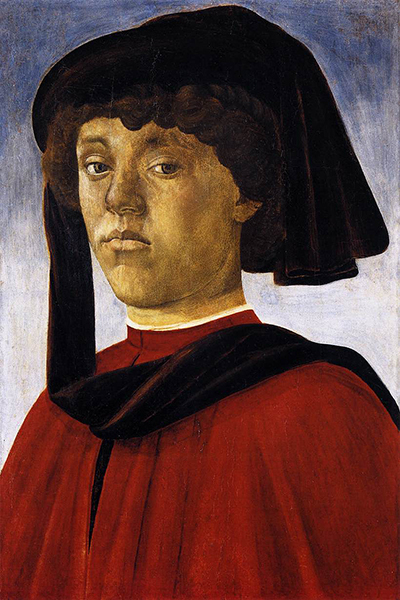This portrait was produced somewhere between the years of 1470–1475 using tempera on panel. It is relatively small, at around 51cm in height. It remains today within the collection of the Palazzo Pitti which is based in the artist's native Florence.
A young man looks directly at us here in simple but smart clothing. His red cloak covers his body up to the next line, with a slim white outline marks its end point. He also wears a black or brown cloth over his head which is wrapped around and then continues down into his left shoulder. His expression is serious and his look can be described as moderately attractive. His hair is dark brown and just appears from underneath his headwear, but the tones are too similar for it to really be particularly obvious. Behind the model we find a blue and white scene without any real detail. This allows the artist to apply light tones to the model, but without distracting us from the main portrait. He would use a similar approach in most of his personal portraits, where people would be placed in front of a window or even against entirely blank backgrounds, either very dark or lighter as shown here. He would produce many portraits of young Florentine men within his oeuvre, including several others in the decade that followed this piece - see Portrait of a Young Man I and II for examples of this.
One interesting historical detail which applies to many of this artist's portraits is how they have actually been misattributed to other artists over the previous centuries. In recent years there has been considerable improvements in the ways in which we analyse historical art, leading to better clarity with regards their respective origins. The items from Botticelli's career that have made it into major art galleries have enjoyed the best levels of preservation because of the resources that these institutions have available to them, whist they can also call upon scientific techniques to get a better understanding of each of the paintings found in their collections. One word of warning is that it can be in the interest of any owner to attribute a piece to as famous an artist as possible and so in some cases you might still treat these attributions with an element of caution, particularly if there is no support from other sources.
The Palazzo Pitti features a large number of different rooms which are each adorned with some classic art, with the main focus of the collection being the Italian Renaissance. The venue helps to remind us of the strength of the Kingdom of Florence prior to Italy becoming a unified nation. We also see many examples of how Florence was an integral part of the Renaissance, contributing many of its most important and innovative contributors, with Botticelli rightly being considered one of those. They own artists from other parts of Italy as well. See several works from Titian, for example, with the likes of Christ the Redeemer, The Concert and one of his portraits of Isabella d'Este. Verrocchio's St Jerome is also a highly memorable part of the collection, as is Andrea del Sarto's Pieta with Saints.




